![]()
![]()
![]()
Use LEFT and RIGHT arrow keys to navigate between flashcards;
Use UP and DOWN arrow keys to flip the card;
H to show hint;
A reads text to speech;
100 Cards in this Set
- Front
- Back
|
Which of the following artifacts may result in an axial and lateral displacement of a reflector on the ultrasound image? A. Refraction B. Side lobe C. Multipath reflections D. Partial volume E. Enhancement |
C: Multipath reflections A multipath artifact is created when the sound beam bounces off of one or more reflectors before it encounters a reflector that redirects it back to the transducer. The increased round-trip time of the echo leads to its incorrect axial and lateral placement in the image. Because the artifact is caused by reflections that take multiple paths to reach the transducer, it is called multipath. |
|
|
Which imaging technique may increase visualization of the reflections from blood flow on the real-time ultrasound image? A. Compound imaging B. Tissue harmonic imaging C. 3D imaging D. Tomographic imaging E. Speckle reduction imaging |
B. Tissue harmonic imaging Moving blood flow is more likely to be seen on the real-time ultrasound image with tissue harmonic imaging because of the reduced clutter, improved contrast resolution, and higher frequency (which results in greater scattering from the RBCs since they are Rayleigh scatterers). |
|
|
While scanning a curved structure, you notice shadowing at the lateral edges of the structure. What is required for this artifact to occur? A. Different media propagation speeds B. Perpendicular incidence C. Transmit frequency exceeding 5 MHz D. Fluid-filled structure in the path of the beam E. Phased array transducer |
A. Different media propagation speeds |
|
|
What artifact is being described in the previous question? A. Grating lobes B. Comet tail C. Acoustic speckle D. Ring-down E. Refraction |
E. Refraction |
|
|
The range equation describes the relationship between: A. Acoustic impedance of two media B. Side lobe intensity between two crystals C. Round-trip pulse travel time and distance to the reflector D. Bandwidth and transducer frequency E. All of the above |
C. Round-trip pulse travel time and distance to the reflector |
|
|
Requirements of magnetic field tracking for 3D reconstruction include: A. Minimization of electromagnetic interference. B. Transmitter must be in close proximity to the receiver. C. Ferrous metals must not be within the electromagnetic field. D. A and B only E. All of the above |
E. All of the above Magnetic field tracking is a successful method of obtaining a 3D dataset and is based on a six degree-of-freedom magnetic field sensor. A transmitter produces a magnetic field and the sensor (on the transducer) receives the signal allowing the position and angulation of the transducer to be tracked (within the field). |
|
|
Which of the following artifacts is the result of reverberation? A. Comet tail B. Acoustic speckle C. Beamwidth D. Refraction E. All of the above |
A. Comet tail The comet tail artifact is commonly seen with metallic objects. Multiple reverberations within a highly reflective object cause the artifact. A reverberation occurs when the sound bounces back and forth multiple times between two interfaces. |
|
|
Which of the following artifacts commonly results in echoes filling in the lumen of small vessels? A. Refraction B. Partial volume C. Mirror image D. Range ambiguity E. Multipath |
B. Partial volume |
|
|
Propagation speed error results in which sonographic appearance? A. Improper lateral position of an echo B. Improper axial position of an echo C. Shadowing behind an echo D. Enhancement behind an echo E. None of the above |
B. Improper axial position of an echo If the propagation speed through a mass differs significantly from that of surrounding tissue, improper axial position of the mass will occur. Why? The ultrasound system is set up to assume that the speed of sound is constant at 1540 m/s. If it is much slower than this, it will take longer for the ultrasound to travel roundtrip to and from a reflector, and the reflections will be placed deeper in the image. Conversely, if the propagation speed through a mass is significantly faster than that of surrounding tissue, the round-trip travel time will be reduced, and the reflections will be placed shallower in the image. Answer choice A - "improper lateral position of an echo" - wound be correct only in the case of refraction, which requires propagation speed difference and oblique incidence. The term propagation speed error does not apply to the phenomenon, however. Answer "B" is therefore the best and correct answer. |
|
|
When you select harmonic imaging, which artifact is less likely to be observed? A. Refraction B. Shadowing C. Ring-down D. Grating lobes E. Speed of sound |
D. Grating lobes |
|
|
When you select compound imaging, which artifact is less likely to be observed? A. Refraction B. Shadowing C. Enhancement D. Acoustic speckle E. All of the above |
E. All of the above Since the beam is steered at the anatomy from multiple directions and formed into a composite image, some artifacts are less likely to be observed with compound imaging. |
|
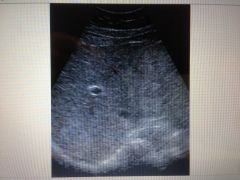
The salt and pepper appearance you observe in this ultrasound image is a result of: A. Acoustic speckle B. Compound imaging C. Harmonic imaging D. Electromagnetic interference E. Refraction |
A. Acoustic speckle |
|
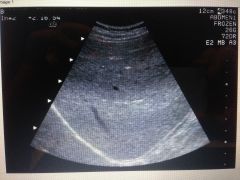
This image exhibits banding. This is a result of: A. Dead transducer element B. Incorrect TGC C. Incorrect master gain D. Incorrect focal zone position E. Incorrect probe pressure |
B. Incorrect TGC |
|
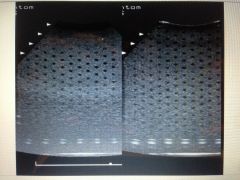
What imaging artifact is much worse on the left phantom image compared to the right phantom image? A. Reverberation B. Volume averaging C. Range ambiguity D. Multipath E. Refraction |
B. Volume averaging |
|

What type of transducer will approve will improve the volume averaging demonstrated in this image? A. Linear array B. 1.5D or multi-row array C. Mechanical 3D D. Phased array E. Mechanical sector |
B. 1.5D or multi-row array |
|

This image was obtained with a linear array transducer that employs phasing to steer the beam. What artifact do the arrows point to? A. Grating lobes B. Reverberation C. Mirror image D. Slice thickness E. Multipath reflections |
A. Grating lobes Grating lobes are a summation of side lobes generated by array transducers. Grating lobes cause a smearing of the ultrasound beam and degrade lateral resolution. The smeared echoes on the edge of this image are related to grating lobes. |
|
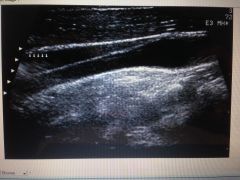
What can be done to reduce the presence of the grating lobes (arrows) seen in this image obtained with a linear array transducer that employs phasing to steer the beam? A. Reduce or eliminate beam steering B. Change the angle of incidence C. Use dynamic aperture D. Increase number of rows of elements in z-axis E. Decrease number of focal zones |
A. Reduce or eliminate beam steering. Grating lobes are usually relatively small compared to the main lobe when the sound beam is unsteered. But with beam steering (as in the trapezoidal display in this image), grating lobes become more prominent in the image. One method of decreasing grating lobes during the manufacturing process of ultrasound transducers is to use a method called subdicing, in which each major element is divided into smaller parts. |
|
|
Complete destructive interference of echo reflections will affect the display in the following way: A. Bright white pixel B. Black pixel C. Dark gray pixel D. Light gray pixel E. None of the above |
B. Black pixel |
|
|
You are observing a sonographic artifact based on the interference patterns of scattered echoes. What artifact are you imaging? A. Mirror B. Grating lobe C. Acoustic speckle D. Comet tail E. Refraction |
C. Acoustic speckle |
|
|
Which of the following will decrease the presence of acoustic speckle in your image? A. Use frame averaging B. Use compound imaging C. Reduce the output power D. Increase the overall gain E. A and B |
E. A and B |
|
|
If you wish to improve border definition, what imaging enhancement should you use? A. Use a lower line density B. Use a 2D array transducer C. Use spatial compound imaging D. Apply a speckle reduction algorithm E. Use frame averaging |
C. Use spatial compound imaging |
|
|
Selective reception of echoes generated within the body by nonlinear propagation describes: A. Compound imaging B. Tissue harmonic imaging C. Speckle reduction imaging D. 3D imaging E. Tomographic ultrasound imaging |
B. Tissue harmonic imaging |
|
|
What can you do to improve visualization of distal acoustic shadowing from calcification? A. Compound imaging B. Tissue harmonic imaging C. Speckle reduction imaging D. 3D imaging E. Tomographic ultrasound imaging |
B. Tissue harmonic imaging Tissue harmonic imaging produces a thinner beam and improved contrast resolution. Demonstration of acoustic shadowing from small calcifications is improved by reducing slice thickness with a thinner beam. Compound imaging actually reduces the appearance of shadowing in the image. |
|
|
Which artifact is associated with resonance of a gas bubble? A. Grating lobes B. Comet tail C. Acoustic speckle D. Ring-down E. Refraction |
D. Ring-down |
|
|
What artifact will you see in the color Doppler image if you cannot increase the PRF to a level greater than 2 times that of the Doppler frequency shift? A. Range ambiguity B. Overestimation of the flow velocity C. Overestimation of the Doppler frequency shift D. Aliasing E. All of the above |
D. Aliasing The Doppler PRF sets the Nyquist limit. Aliasing occurs when the frequency shift exceeds 1/2 the system pulse repetition frequency (PRF). |
|
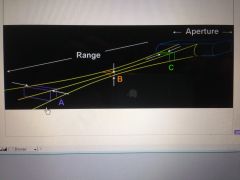
In this illustration, letter A is demonstrating what type of resolution? A. Axial B. Lateral C. Elevation D. Contrast E. Temporal |
B. Lateral |
|
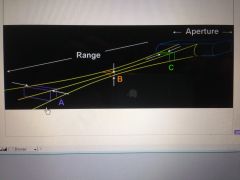
In this illustration, letter B is demonstrating what type of resolution? A. Axial B. Lateral C. Elevation D. Contrast E. Temporal |
C. Elevation |
|
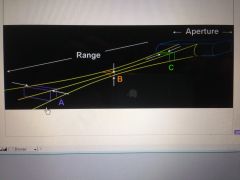
In this illustration, letter C is demonstrating what type of resolution? A. Axial B. Lateral C. Elevation D. Contrast E. Temporal |
A. Axial |
|
|
Which of the following helps to improve the axial resolution in a B-mode image? A. Increased aperture B. Increased bandwidth C. Focusing with an acoustic lens D. Increased dynamic range E. Beam steering |
B. Increased bandwidth |
|
|
Which of the following helps to improve the lateral resolution in a B-mode image? A. Increased aperture B. Increased bandwidth C. Focusing with an acoustic lens D. Increased dynamic range E. Beam steering |
A. Increased aperture |
|
|
Which of the following helps to improve the elevation resolution in a B-mode image? A. Increased transmit power B. Increased bandwidth C. Focusing with an acoustic lens D. Increased dynamic range E. Beam steering |
C. Focusing with an acoustic lens |
|
|
What technique would be most helpful in reducing grating lobes in your image? A. Beam steering B. Compound imaging C. 3D imaging D. Speckle reduction imaging E. Tissue harmonic imaging |
E. Tissue harmonic imaging |
|
|
What technique would be most likely to produce grating lobes in your image? A. Beam steering B. Tomographic ultrasound imaging C. 3D imaging D. Speckle reduction imaging E. Tissue harmonic imaging |
A. Beam steering |
|
|
A standard for handling and transferring images and medical information between computers is: A. Voxel B. DICOM C. HIPAA D. VPN E. Worklist |
B. DICOM DICOM stands for Digital Imaging and Communications in Medicine |
|
|
What feature would you use if you wish to recall a previous exam from the PACS system to your ultrasound machine? A. Storage Commitment B. Worklist C. DICOM Store D. Query/Retrieve E. HIPAA |
D. Query/Retrieve This is a DICOM feature that allows you to recall a previous DICOM study (CT/MR/Ultrasound/etc.) onto your ultrasound system for viewing. |
|
|
A DICOM feature that allows you to select a patient name and have it automatically populate the patient information on the ultrasound system is: A. VPN B. PRN C. Worklist D. JAVA E. HIPAA |
C. Worklist |
|
|
You are performing a 3D sonogram and notice the volume rate is 8 Hz. What does this represent? A. Number of transmitted sound pulses per second B. Number of received pulses per minute C. Number of volumes displayed per second D. Number of frames per volume E. Number of frames per second |
C. Number of volumes displayed per second |
|
|
Sonographic images are usually compressed before sending to PACS in order to: A. Reduce the time to transmit the image B. Increase the spatial resolution of the image C. Preserve measurements with the image data D. Reduce costs by lowering image quality E. Increase the real-time image frame rate |
A. Reduce the time to transmit the image |
|
|
Using the Modality Worklist has the advantage of: A. Avoiding the need to type patient information B. Reducing patient information error C. Speeding up patient preparation time D. Easily confirming patient information E. All of the above |
E. All of the above |
|
|
What term is used to describe a 3-dimensional pixel element in 3D sonography? A. Volume point B. Voxel C. Quadrant D. Channel E. All of the above |
B. Voxel The term "voxel" is used to describe the smallest element of a 3-dimensional volume. It is analogous to the term "pixel" in 2D imaging. |
|
|
A type of sonographic imaging that transmits two pulses of opposite phase in rapid succession so they can be cancelled out upon reception is termed: A. Pulse inversion harmonics B. Compound imaging C. Speckle reduction imaging D. Tomographic imaging E. Panoramic imaging |
A. Pulse inversion harmonics Pulse inversion harmonics is an effective method to filter out the fundamental frequency (transmitted frequency) and leave only the harmonic frequencies for display. It uses two pulses of opposite polarity transmitted into the tissue in rapid succession. The received echoes from the pulses are added together and will cancel out the transmitted frequency leaving the harmonics that were generated within the tissue. |
|
|
What 2D limitation is addressed by 3D ultrasound imaging? A. 3D provides higher frame rate B. 3D provides improved spatial resolution C. 3D provides visibility of the coronal plane. D. 3D transducers are typically smaller and lighter than standard 2D transducers. E. 3D imaging requires no training of the person performing the study. |
C. 3D provides visibility of the coronal plane. The coronal plane is not routinely imaged in most sonographic applications with 2D imaging. With 3D imaging, multiplanar reformatting can be performed to demonstrate an infinite number of scan planes, including the coronal plane. |
|
|
A system commonly used to handle the archiving and electronic distribution of sonographic images using a DICOM format is: A. VHS B. DVD C. USB D. MOD E. PACS |
E. PACS PACS stands for Picture Archive and Communication System |
|
|
You are using an ultrasound examination mode that is useful for measuring dimensions of structures. This mode produces a display more similar to a tracing rather than an actual anatomic picture. Which of the following most closely matches this description? A. Duplex mode B. B-Mode C. C-Mode D. M-Mode E. P-Mode |
D. M-Mode |
|
|
Which artifact is related to beam attenuation? A. Comet tail B. Aliasing C. Enhancement D. Reverberation E. Side lobe |
C. Enhancement Enhancement occurs distal to a structure that has less attenuation of the sound beam compared to the surrounding tissue. Hence, there is more signal beyond it and the reflections have greater amplitude resulting in a brighter image. |
|
|
What is the main advantage you will have by choosing a transducer that produces a thin slice over the image plane? A. Improved frame rate B. Decreased volume averaging C. Better axial resolution D. Larger field of view E. Greater penetration |
B. Decreased volume averaging The slice thickness is controlled by the out-of-plane focusing. The out-of-plane focusing is usually accomplished by an acoustic lens, which provides focusing at one depth along the beam. Slice thickness is the worst measure of resolution in sonography (compared to lateral and axial resolution). Matrix or 2D array transducers are capable of focusing the sound beam electronically at multiple points in the out-of-plane dimension. This produces a thinner beam compared to traditional 1D array transducers. The thinner the beam, the more accurately a structure can be imaged without interference from surrounding tissue. When the beam is wider than the structure being interrogated, tissue on both sides of the structure send back reflections at the same time. The sonographic system cannot distinguish between these reflections (since they arrive simultateously), and so the echoes are combined on the display. The result is termed volume averaging, partial volume effect, or slice thickness artifact. An example would be to image a fluid structure with a wide beam and see artifactual echoes within it from the tissue on each side that is within the beam at the same instant. |
|
|
What artifact might you see with an array transducer due to energy that propagates from the transducer in a direction different from the primary beam? A. Grating lobe B. Mirror image C. Reverberation D. Range ambiguity E. Acoustic enhancement |
A. Grating lobe Grating lobes are the same as side lobes, but occur with array transducers. These lobes are sound energy traveling from the transducer array in a direction different than the main beam. They generally are much weaker than the main beam and do not produce tissue reflections with enough strength to be displayed. But in some cases they may strike a strong reflector or be strong enough to cause artifactual echoes in the image. They are most easily seen when imaging fluid because of the decreased attenuation and increased visibility of artifacts. |
|
|
What type of focusing is performed by delay circuitry upon reception? A. Dynamic receive focusing B. Elevational focusing C. Transmit focus D. Multizone transmit E. Mechanical focusing |
A. Dynamic receive focusing |
|
|
What type of imaging results in selective reception of frequencies that are 2 times that of the transmitted frequency? A. Color Doppler imaging B. Pulsed Doppler imaging C. Tissue Doppler imaging D. M-Mode imaging E. Tissue harmonic imaging |
E. Tissue harmonic imaging In tissue harmonic imaging, the receiver selectively "listens" to the harmonic frequencies that were generated as the sound traveled through the tissue. The second harmonic is the strongest harmonic produced. This is twice the transmitted frequency. |
|
|
When you select one focal zone, how many pulse/listen cycles are required for each acoustic scan line in one image frame? A. One B. Two C. Four D. Eight E. Sixteen |
A. One |
|
|
What is the maximum velocity limit for a 3 MHz CW Doppler unit operating at depth of 4 cm A. 40 cm/s B. 200 cm/s C. 2.5 m/s D. 4 m/s E. None of the above |
E. None of the above CW (continuous-wave) Doppler does not have an imposed maximum velocity limit like PW (pulsed-wave) Doppler. In fact, CW Doppler may be used in instances where accurate velocities cannot be obtained with PW Doppler. |
|
|
You will see aliasing of the Doppler spectrum occurs whenever the frequency shift exceeds: A. Twice the pulse repetition frequency B. Three times the pulse repetition frequency C. One-third the pulse repetition frequency D. One-half the pulse repetition frequency E. One-fourth the pulse repetition frequency |
D. One-half the pulse repetition frequency Aliasing of the Doppler spectrum is an artifact that occurs with PW Doppler when the frequency shift is greater than 1/2 the Doppler PRF. |
|
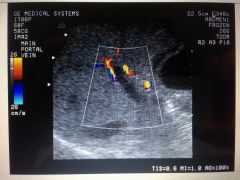
You obtained this color Doppler image during a hepatic sonogram. There is no color signal detected within the portal vein. What can you do to improve sensitivity to slow flow? A. Increase wall filter B. Decrease packet size C. Decrease color gain D. Decrease pulse repetition frequency E. Change color map |
D. Decrease pulse repetition frequency When slow flow is present, the color Doppler system must be sensitized to detect low-frequency shifts (slow flow produces low-frequency shifts). Setting PRF lower increases sensitivity to low-frequency shifts. At low PRFs there is more time between the pulses, which allows time for the slow moving blood flow to move and be detected by the system. Other methods of improving sensitivity to slow flow include decreasing the wall filter and increasing the Doppler frequency. |
|
|
The packet size in color Doppler refers to the number of: A. Pulses per second B. Sample volumes per scan line C. Scan lines per unit area D. Pulse/listen cycles per acoustic scan line E. Pulses required to create one frame |
D. Pulse/listen cycles per acoustic scan line For color Doppler, each line of sight must be pulsed multiple times. Then number of pulses per line is termed ensemble length, packet size, or shots per line. The number of pulses transmitted in one second is the pulse repetition frequency (PRF). How many of those pulses are fired on each scan line is the ensemble length. |
|
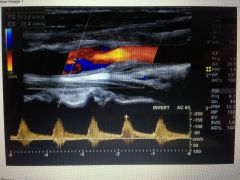
Which of the following is present in this Doppler waveform? A. Spectral broadening B. Narrow velocity range C. Aliasing D. Mirror imaging E. Range ambiguity |
A. Spectral broadening The waveform shows fill-in of the spectral window. This loss of the window is indicative of spectral broadening. Spectral broadening is associated with turbulent flow. |
|
|
While performing a Doppler study, the measurement of the Doppler angle of incidence was underestimated. What error will result from this mistake? A. The frequency shift will be underestimated B. No Doppler frequency shift will be detected C. Mirror imaging of the Doppler spectrum will occur D. The velocity estimation will be inaccurate E. Aliasing of the Doppler spectrum will occur. |
D. The velocity estimation will be inaccurate. The velocity estimation in Doppler ultrasound is based on measurement of the Doppler angle of incidence - the angle at which the Doppler beam intersects the blood flow. Because the blood flow is not directly visualized, the Doppler angle-correction cursor is aligned parallel to the walls of the vessel at the point of the sampling. If this measurement is underestimated, the velocity of the flow will be underestimated. If this measurement is overestimated, the velocity of flow will be overestimated. Any time the angle-correction cursor is not adjusted parallel to the wall, the velocity estimation is in error. |
|
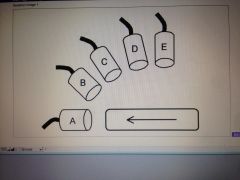
Five transducers are imaging a vessel at different incident angles. The arrow indicates the direction of blood flow. Which transducer will detect the largest Doppler frequency shift? A. A B. B C. C D. D E. E |
A. A The transducer labeled A is firing its beam at a 0 degree angle to flow. For any given velocity of flow, the maximum frequency shift will be obtained at 0 degree. |
|
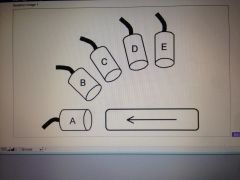
Five transducers are imaging a vessel at different incident angles. The arrow indicates the direction of blood flow. Which transducer would not detect a Doppler frequency shift? A. A B. B C. C D. D E. E |
E. E The transducer labeled E is firing its beam at a 90 degrees angle to flow. The Doppler equation tells us that we cannot detect a frequency shift at a incident angle of 90 degrees. |
|
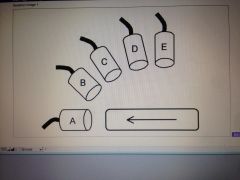
Five transducers are imaging a vessel at different incident angles. The arrow indicates the direction of blood flow. Which transducer would demonstrate a waveform ABOVE the zero baseline? A. A B. B C. C D. D E. All except for E |
E. All except for E |
|
|
A commonly used process for determining direction in a Doppler instrument is: A. Zero-crossing detection B. Autocorrelation C. Phase quadrature detection D. Range gating E. Spectral analysis |
C. Phase quadrature detection |
|
|
What method is used to steer the color beam with a linear array transducer? A. Mechanical B. Electronic time delays C. Electronic voltage variation D. Apodization E. The color beam cannot be steered with a linear array transducer |
B. Electronic time delays A linear array transducer steers the beam for color Doppler in the same way a phased array transducer steers its beam-electronically. The active elements are fired with very slight time delays, causing the beam to veer off at an angle from the transducer face. |
|
|
When color Doppler is activated, in order to maintain frame rate, what may be reduced in the underlying B-mode image? A. The number of focal zones B. The scan line density C. The frame averaging D. A and B E. B and C |
D. A and B To maintain an adequate frame rate in color Doppler, the B-mode image is compromised by reducing the number of focal zones to 1 or 2 and by reducing the scan line density which results in lower lateral resolution. |
|
|
What Doppler technique does NOT provide range resolution? A. Color Doppler B. Power Doppler C. Pulsed-Wave Doppler D. Continous-Wave Doppler E. No Doppler technique can provide range resolution |
D. Continuous-Wave Doppler Range resolution is the ability to determine the depth from which an echo has arrived. For range resolution, the sound must be pulsed so that the echo arrival time from each pulse can be measured. By knowing the arrival time of the echo, the distance to the reflector can be determined. This works because we know the speed of sound in tissue and assume it to be constant. |
|
|
You have obtained a color Doppler image of the common carotid artery. If the received ultrasound frequency is greater than the transmitted ultrasound frequency, which of the following would be correct? A. Color encoding red, negative Doppler shift B. Color encoding blue, negative Doppler shift C. Color encoding red, positive Doppler shift D. Color encoding blue, positive Doppler shift E. No doppler shift detected |
C. Color encoding red, positive Doppler shift When the Doppler ultrasound beam intersects a vessel in which the blood is flowing toward the Doppler beam, the frequency of the reflected signal is higher than that of the transmitted signal. This is termed a positive frequency shift. All Doppler systems are set up so that positive Doppler shifts are color-encoded red and negative Doppler shifts are color-encoded blue. The specific color map in use determines the shading of red and blue and the colors in between. An Invert function is available on most systems that allows the user to reverse the color designation. |
|
|
Aliasing is a potential problem in PW Doppler because of: A. The use of high pulse repetition frequencies B. The Doppler signal being sampled rather than recorded continuously C. Dynamic focusing D. The motion of the interface perpendicular to ultrasound wave propagation E. Perpendicular incidence |
B. The Doppler signal being sampled rather than recorded continuously Aliasing occurs because the frequency-shifted signal is not adequately sampled. The sampling rate is set by the system pulse repetition frequency (PRF). If the frequency shift exceeds 1/2 the PRF, aliasing of the signal will occur. |
|
|
What does the Doppler signal spectral display depict? A. Relative signal power at each frequency in the Doppler signal B. Depth to each vessel C. Volume flow rate D. Transmit frequency E. Acoustic power |
A. Relative signal power at each frequency in the Doppler signal The Doppler signal spectral display depicts the frequency bandwidth and range of amplitudes in the reflected signal. The amplitude or signal power depends on the relative number of red blood cells comprising each component of the frequency-shift spectrum. |
|
|
Increasing the wall filter during Doppler sampling will: A. Increase visibility of low velocity signals B. Increase spectral broadening C. Decrease bandwidth D. Reduce display of low-frequency shifts E. Reduce aliasing |
D. Reduce display of low-frequency shifts The wall filter (also known as high pass filter) is used to eliminate frequency shifts below a set threshold from the display. If the filter is set at 50 Hz, then any frequency shift of 50 Hz or less will not be displayed. Increasing the wall filter helps to eliminate the high amplitude, low-frequency shift signals caused by movement of the vessel wall. Nevertheless, it must be kept in mind that low-frequency shifts may be a result of slow flow. So any time the wall filter is increased, the system is less sensitive to slow flow. |
|
|
What would be the most likely result from increasing the transmit frequency of the color Doppler? A. Improved sensitivity to slow flow B. Improved penetration for imaging flow in deep tissues C. Reduced flash artifact obscuring small vessel flow D. Reduced color Doppler aliasing E. Improved visibility of complex flow hemodynamics |
A. Improved sensitivity to slow flow Increasing the color Doppler transmit frequency shifts from slow flow and thus, improved visibility. It will decrease penetration to flow in vessels deep within the tissues. Changing the ultrasound frequency has a negligible effect on frame rate, flash artifact, or visualization of complex flow hemodynamics. Although one could argue that the increased frequency shifts from slow moving tissue would be more visible with higher frequencies and may result in increased flash artifact, nevertheless, increased visibility of slow flow is the best answer to this question. |
|
|
What would be the most likely result from lowering the color threshold? A. Increased visibility of small vessel flow in a parenchymal organ B. Decreased flash artifact C. Increased color writing on the vessel or cardiac wall D. Increased frame rate E. Improved color penetration |
C. Increased color writing on the vessel or cardiac wall The threshold controls the brightness of the shade of gray that the color is allowed to overwrite. If the threshold is lowered, it is more likely that the color will overwrite the vessel or cardiac wall. Axial resolution in color Doppler almost always is poorer than that in B-mode. |
|
|
What method is most commonly used to perform spectral analysis for pulsed Doppler? A. Zero-crossing detection B. Fourier analysis C. Reynolds number D. Cross-correlation E. Autocorrelation |
B. Fourier analysis |
|
|
During Doppler interrogation of the carotid artery, you detect spectral mirroring. Which of the following is a common cause of this artifact? A. Doppler angle of interrogation near 90 degrees B. Doppler angle of interrogation near 0 degrees C. Wall filter set too high D. PRF set too low E. Doppler gain set too low |
A. Doppler angle of interrogation near 90 degrees At a 90 degree Doppler angle, flow direction cannot be determined and the waveform will be seen on both sides of the baseline. |
|
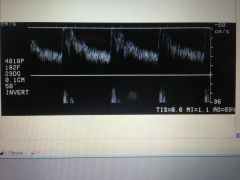
This Doppler waveform can be most accurately described as exhibiting: A. Aliasing B. Spectral broadening C. Mirror image D. Bidirectional flow E. Saturation |
A. Aliasing With an aliased signal, the peak of the waveform is clipped off and appears on the opposite side of the baseline. It starts from the bottom of the image and points up toward the baseline. It does not start from the baseline and point down. That would indicate retrograde flow. |
|
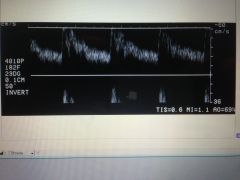
What system control should be adjusted to optimize this waveform? A. Wall filter B. Packet size C. Gain D. Pulse repetition frequency E. Sample volume size |
D. Pulse repetition frequencyBecause aliasing occurs when the frequency shift exceeds 1/2 the PRF, the frequency at which aliasing occurs increases as the PRF increases. Depending on the ultrasound system, the PRF control may be called Velocity Scale, Velocity Range, Flow Rate, or other terms. Whatever it is called, it controls PRF. |
|
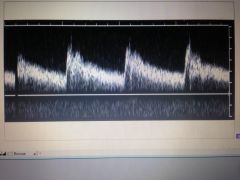
What Doppler control should be adjusted to optimize this Doppler spectral waveform? A. Wall filter B. Packet size C. Gain D. Pulse repetition frequency E. Baseline |
C. Gain The gain should be reduced. There is noise in the background behind the spectrum and within the spectral window because the gain is set too high. Changing the sample volume would not affect background noise, nor would changing the wall filter setting. |
|
|
The Doppler frequency shift is defined as: A. The difference between the Doppler frequency and the imaging frequency B. The difference between the transmitted and received frequencies C. The time between the transmitted and received pulses D. The rate at which the transducer emits pulses E. The amplitude of the transmitted Doppler signal |
B. The difference between the transmitted and received frequencies The Doppler effect causes the transmitted Doppler frequency to be altered when it encounters a moving reflector. The frequency is increased if the reflector is moving toward the beam and decreased if the reflector is moving away from the beam. The difference that occurs between the transmitted frequency and the altered frequency that is reflected back is known as the frequency shift. |
|
|
According to the Doppler equation, which of the following is NOT true? A. Increasing Doppler frequency will increase the frequency shift. B. Increasing Doppler interrogation angle will increase the frequency shift C. Decreasing the reflector speed will decrease the frequency shift D. No frequency shift is detected when the Doppler beam strikes the reflector with perpendicular incidence. E. Velocity information can be obtained from the frequency shift if the angle of incidence is known. |
B. Increasing Doppler interrogation angle will increase the frequency shift |
|
|
The Nyquist limit describes which of the following? A. Penetration limit of pulsed-wave Doppler B. Transit time of pulsed-wave Doppler C. Sampling frequency needed for detecting the Doppler signal unambiguously D. Sampling method used for continuous-wave Doppler E. Used for determining directional information in a Doppler-shifted signal |
C. Sampling frequency needed for detecting the Doppler signal unambiguously |
|
|
What information does the z-axis (brightness) on the Doppler spectrum provide? A. Velocity B. Velocity range C. Bandwidth D. Amplitude E. Frequency shift |
D. Amplitude The z-axis on the Doppler spectrum is represented by the brightness of the dot. The brighter the dot, the greater the amplitude of the reflected signal. The factor affecting the amplitude is the relative number of RBCs reflecting that particular frequency shift. So by noting the brightness of a specific point on the spectral waveform we can get an idea about how much of the flow is moving at any given velocity at a particular point in time. |
|
|
A waveform from the internal carotid artery obtained at a Doppler angle of 45 degrees shows aliasing. Which of the following choices will help you unwrap this waveform? A. Decrease the angle of incidence B. Decrease the high pass filter C. Raise the zero baseline D. Increase the pulse repetition frequency E. Increase the Doppler frequency |
D. Increase the pulse repetition frequency Decreasing the angle of incidence would cause a larger frequency shift for any given velocity and increase the odds of aliasing. The high pass filter has no effect on aliasing. To reduce aliasing, the zero baseline should be lowered instead of raised. Increasing the PRF raises the Nyquist limit and will help reduce aliasing (unwrap the waveform). Increasing the Doppler frequency will result in a larger frequency shift for any given velocity and increase the chances of aliasing. |
|
|
While performing a color Doppler exam in the abdomen you have adjusted several system controls and notice that the frame rate has decreased. Which of the following adjustments can you make to improve the color frame rate? A. Increase the packet size B. Decrease the pulse repetition frequency C. Decrease the color box width D. Increase the scan line density E. Increase the wall filter |
C. Decrease the color box width The wider the color box, the more lines of sight that must be fired to create one frame. So decreasing the width of the box will improve the frame rate. Increasing the packet size will increase the frame rate. Decreasing the pulse repetition frequency may or may not affect the frame rate, but is more likely to decrease it rather than increase it. Increasing the scan line density will decrease the frame rate. Adjusting the wall filter will not affect the frame rate |
|
|
You are performing a carotid duplex examination with the following parameters: 5 MHz Doppler frequency, 6kHz PRF, 4 cm depth, and 1.5 mm sample volume length. What is the aliasing frequency? A. 5 MHz B. 6 kHz C. 12 kHz D. 1.5 MHz E. 3 kHz |
E. 3 kHz The only factor that is useful in determining the point of aliasing (Nyquist limit) is the PRF. Aliasing occurs when the frequency shift exceeds 1/2 the PRF. |
|
|
The rapid technique used in most color Doppler systems to obtain the mean Doppler frequency shift is: A. Fast Fourier transform B. Phase quadrature C. Autocorrelation D. Zero-crossing detectors E. Variance |
C. Autocorrelation |
|
|
What information is colorized in an image using power Doppler? A. Frequency shift B. Flow velocity C. Doppler signal amplititude D. Frequency bandwidth E. Acoustic power |
C. Doppler signal amplititude Power Doppler colorizes the amplitude of the reflected Doppler signal. This brightness of the colors is related to the number of red blood cells. |
|

In the following waveform, the end-diastolic flow velocity cannot be measured. What control adjustment should be performed to obtain this measurement? A. Increase the pulse repetition frequency B. Decrease the angle of incidence C. Lower the zero baseline D. Increase the Doppler gain E. Lower the wall filter |
E. Lower the wall filter |
|
|
You have encountered spectral broadening of the internal carotid artery waveform. This most likely indicates: A. Slow heart rate B. Tachycardia C. Accelerated flow D. Turbulent flow E. High resistance flow |
D. Turbulent flow Distal to a stenosis, flow becomes turbulent, demonstrating many different speeds and directions (although net flow is still in the forward direction). This range of speeds and directions results in the reflection of a wide range of frequency shifts that is termed spectral broadening. As the term implies, it is simply a broadening of the spectrum of frequencies reflected back to the transducer. |
|
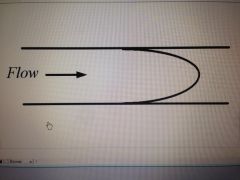
What flow characteristic is depicted in this illustration? A. Turbulent flow B. Blunt flow profile C. Flat flow profile D. Stenotic flow profile E. Parabolic flow profile |
E. Parabolic flow profile |
|
|
What term describes the number of pulses that are used to determine the velocity along a color line of sight? A. Color gate B. Packet size C. Pulse repetition frequency D. Pulse duration E. Pulse repetition period |
B. Packet size The packet size is also known as ensemble length or shots per line. |
|
|
What display method below will help you to demonstrate flow turbulence with color Doppler? A. Autocorrelation B. Variance C. Fast Fourier analysis D. Zero-crossing detection E. Phase quadrature detection |
B. Variance Variance maps have a green shade that is used to indicate turbulence. Although they may be used anywhere in the body, variance maps are primarily used for cardiac scanning. Variance maps should not be confused with rainbow maps, which contain some green adjacent to the blue color. These maps are commonly used in vascular scanning. With rainbow maps, the green does not indicate turbulence, but merely helps to differentiate levels of frequency shifts in the negative direction. |
|
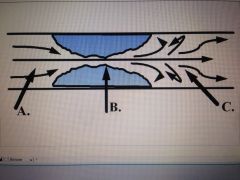
What term would describe a Doppler waveform obtained at location "C" in this depiction of an arterial stenosis? A. Parabolic flow profile B. Laminar flow profile C. Plug flow profile D. Spectral broadening flow profile E. Dampened flow profile |
D. Spectral broadening flow profile |
|
|
What parameter describes the axial length of the sampling volume for a color pixel? A. Color gate B. Packet size C. Pulse repetition frequency D. Pulse repetition period E. Line density |
A. Color gate |
|
|
What type of Doppler device uses two elements, one to receive and one to transmit? A. Power Doppler B. Color Doppler C. Continuous-wave Doppler D. Pulsed-wave Doppler E. All of the above |
C. Continuous-wave Doppler |
|
|
Spectral analysis is used to: A. Determine the distribution and magnitude of frequency shifts in the reflected Doppler signal. B. Eliminate aliasing from the reflected signal. C. Color-encode the Doppler frequency shift D. Eliminate low-frequency shifts from the display. E. Determine the velocity of the moving reflector. |
A. Determine the distribution and magnitude of the frequency shifts in the reflected Doppler signal. |
|
|
Color flash artifact is obscuring the anatomy of interest in an exam of the abdominal aorta. What can you do to reduce impact of the flash? A. Increase the color gain B. Decrease the pulse repetition frequency C. Increase the wall filter D. Increase the packet size E. Increase the Doppler transmit frequency |
C. Increase the wall filter Flash artifact is typically a high-amplitude but low-frequency shift signal. It can be reduced on the display by increasing the wall filter. Of course, this comes at a price. Increasing the wall filter also reduces the sensitivity to the low-frequency shifts associated with slow flow. |
|
|
While evaluating the liver vasculature with color Doppler, you are unable to obtain signals from the deeper vessels. What should you do to enhance your ability to demonstrate deep flow? A. Decreased the packet size B. Increase the scan line density C. Increase the wall filter D. Increase the pulse repetition frequency E. Decrease the ultrasound frequency |
E. Decrease the ultrasound frequency Lower frequencies have increased penetration compared to higher frequencies. No other answer choice would improve penetration of the color Doppler. |
|
|
Loss of fluid energy through inertia: A. Is greatest during steady flow through a rigid tube of constant caliber B. Is best described by Poiseuille's law C. Is greatest in a tortuous vessel with multiple obstructions D. Accounts for less energy loss than viscous losses E. Is greatest with high flow speeds in a large tube |
C. Is greatest in a tortuous vessel with multiple obstructions Inertial losses of fluid energy depend upon changes in flow direction and changes in velocity when blood is accelerated or decelerated as in pulsatile flow. Tortuous vessels with multiple obstructions would change the direction as well as the velocity of the blood flow, and this would create the greatest loss of fluid energy through inertia. |
|
|
Which of the following statements about turbulent flow is NOT true? A. It can be predicted by the Reynolds number B. It is responsible for murmurs, bruits, and thrills C. It causes increase in pressure downstream D. It occurs where there are abrupt variations in vessel diameter E. It is affected by velocity. |
C. It causes increase in pressure downstream Pressure is reduced distal to a stenosis in turbulent flow. |
|
|
Which of the following statements most correctly describes the occurrence of diastolic flow reversal in the arterial system? A. It is always an abnormal finding. B. It is seen in and proximal to high-resistance vessels. C. It is most commonly observed in vessels which supply low-resistance beds. D. It can be enhanced by body heating. E. It is found in the internal carotid artery. |
B. It is seen in and proximal to high-resistance vessels. |
|
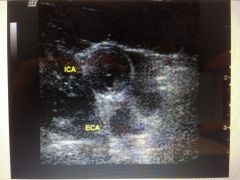
You measured an area reduction of 90% in this artery. This is equal to a diameter reduction of: A. 25% B. 30% C. 50% D. 75% E. 90% |
D. 75% Area percent stenosis and diameter percent stenosis are not equal. A 50% diameter stenosis is approximately equal to a 75% area stenosis and a 75% diameter stenosis is approximately equal to a 90% area stenosis. |
|
|
The Doppler waveform you have obtained from a collateral channel shows high resistance compared to the contralateral normal artery. The increased resistance may be attributed to: A. Decreased tube diameter B. Increased vessel length C. Decreased resistance in the vascular bed D. All of the above E. A and B |
E. A and B Collateral vessels have a longer length and a smaller diameter, both resulting in increased resistance to flow. |
|
|
After a short walking exercise, the venous pressure at the ankle of a standing normal subject: A. Is greater than the standing ankle pressure at rest B. Is lower than the standing ankle pressure at rest C. Is the same as standing ankle pressure at rest D. Is not affected by chronic venous insufficiency E. Is not affected by deep venous thrombosis |
B. Is lower than the standing ankle pressure at rest |

